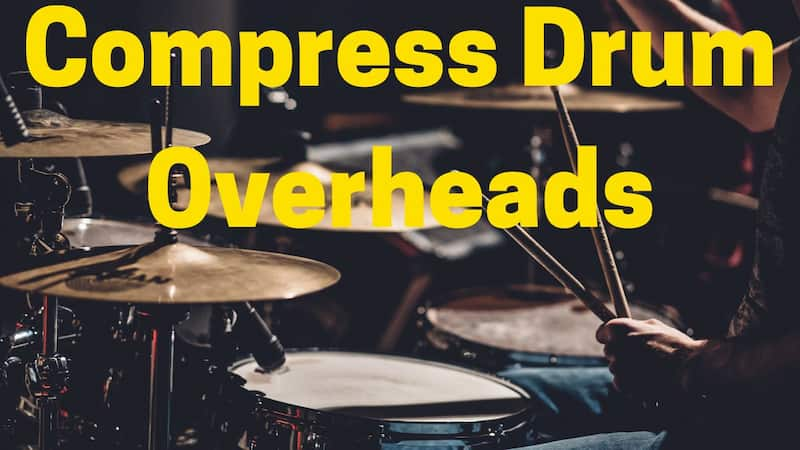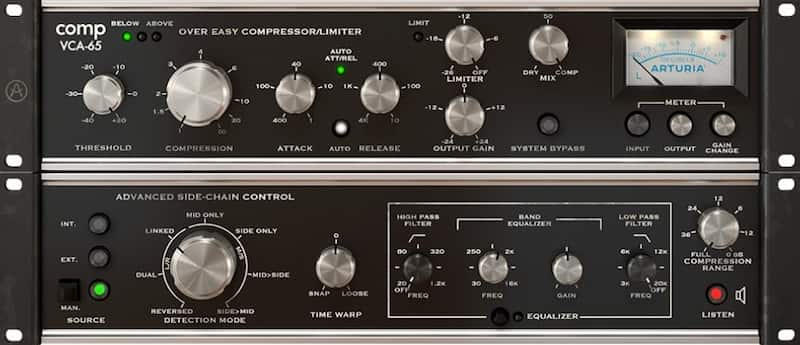Drum Compression Techniques

The compressor is one of the most commonly used processors in mixing. They reduce the audio of a signal when it gets too loud using a predetermined threshold, helping the mix engineer tame loud peaks. While compression plays an important role in mixing just about any instrument, it is especially important with drums.
Today, we’re going to dive in and talk about why compression is so important for mixing drums and how you can use compression to elevate your drum mixes.
Note: This article may contain affiliate links, meaning I would receive a commission - at no cost to you - for any products you purchase.
Why Compress Drums?
Drums are loud instruments. There’s no getting around it. One of the main issues with mixing drums is that they tend to have very sharp peaks on the hits, which can poke you through your mix in a bad way.
By using compression properly, you can clamp down on your drums without absolutely obliterating any semblance of dynamics. With drums, we want that snap, crackle, pop, and sustain to give our mixes life and power. It’s so easy to miss the ball with these characteristics if you don’t understand how to use compression the right way.
Let’s look at a few different elements in your drum mixes that will likely require compression.
If you want to learn how to compress kick drum here is an in-depth article. And read this article if you want to learn everything about snare drum compression.

How To Compress Drum Overheads
Compressing the overheads requires a bit of additional care and attention to get the sound just right. If you have compressor settings that are too fast, for example, you can crush your overheads and get a distorted sound. Of course, this sound could be the right sound for you mix, though, in general, it’s worth understanding how to dial-in clean overhead compression and save the dirt for another processor.
Many mix engineers use FET compressors on overheads to catch peaks in conjunction with a tube or optical compressor for smoothness, color, and depth.
For transparent compression, I typically like to start with a 3:1-4:1 ratio, fast attack, and fast release, and dig in with the threshold until you start to hear the juiciness you’re looking for. If your overheads begin pumping, you can either slow down the release a little bit or raise the threshold.
Of course, you might want to go for a harder, more distorted approach. I absolutely love the All Buttons In setting on the 1176 for overheads, as it provides a nice crunch without destroying dynamics.
How To Compress Tom Toms
If you already know how to approach compressing toms and snares, you can think of the tom as right in-between the two. In super aggressive genres, including rock and metal, heavy compression is a great way to thicken up your toms and give them the power and sustain they need to cut through the mix.
A medium attack is typically a good place to start, as you want to allow the transient of the tom to come through. The release can be timed depending on your tonal preferences. Do you want more sustain? Try a slower release. Less sustain? Faster release!
As for a ratio, 6:1 can be a nice place to start. While it might sound high, it’s not high enough that you’ll suck too much of the dynamics out of your sound. I’ll usually crank the threshold until I’m getting anywhere from 6-10 dB of gain reduction on the highest peaks.
How To Compress Room Mics
Your room microphones are the glue of your drum mix. Most engineers will tell you that the sound of a great drum mix comes from adding a serious amount of compression to the room — anywhere from 6-10dB of gain reduction on the loudest peaks. Doing so can thicken the overall sound of the drums and bring up the best characteristics of the room,
The goal for many engineers is to increase the room size. You should use an attack time that is slow enough so that you don’t crush the transients. As for the release, I typically like to set it to the tempo of the track so my room can breathe in time with the song. As for the ratio, I’ll usually go for 6:1-8:1.
If you’re looking to accentuate the natural tone of your room, you can increase the release time.
Of course, you may not like the sound of your drum room. Low ceilings and unpleasant reflections can often cause problems. One of the best ways to mitigate a room that doesn’t sound good is by using a fast enough attack time to cut down on the transient, as well as a long-enough release time so that you don’t exaggerate the ambiance.
Drum Bus Compression Tips
Drum bus compression is a great way to glue your tracks together, controlling the dynamics of the overall kit and making them seem like they’re part of a single unit.
While compression settings are always specific to the project, we want to go over a good starting point for drum bus compression.
Starting with the ratio, I typically find that keeping my bus compression subtle is the best approach, I’ll use ratios anywhere from 2:1 to 3:1. If I truly need harder-hitting compression, I’ll use parallel compression, which I’ll discuss a bit later.
The threshold often sits low enough to provide anywhere from 2-3dB of compression. Again, I’m looking for glue and subtlety here, saving the hard-hitting compression for parallel.
For attack and release times, I find it’s always best to avoid ultra-fast attack times, as they can crush your transients, eating up the liveliness of your drums. However, while a slow-to-medium attack time is a right way to go, it must be paired with the proper release time.
If you set your release time too slow, your compressor won’t get enough time to reset, impacting some of the transients that we just worked hard to get right.
Best Drum Bus Compressor - Arturia Comp VCA-65
If you’re looking for a quality drum bus compressor, the Arturia Comp VCA-65 is one of my favorites. This drum bus compressor uses solid-state VCA emulation and RMS dynamics detection to provide beautifully-shaped compression, great for any genre. If you’re looking for added punch with your drums, there is truly no better style of compressor.
One of the best things about the Arturia Comp VCA-65 is the “Over Easy” auto attack-decay detection and peak stop limiter, providing natural compression and delivering a bit of dirt when your drums start to hit hard.
Best Waves Drum Bus Compressor - API 2500
With three variable filter types, three compression modes, and a wide variety of controls at your disposal, the API 2500 is one of the most versatile drum bus compressors on the market today. I absolutely love the variable link filter types, as they provide, and the switchable three-position "Thrust" high-pass filter, as they allow you to shape your drums in unique ways while keeping the low-end from taking over the compression.
With the fast attack settings, this compressor has a special way of making transients POP.
Using Parallel Compression on Drums
While there are plenty of ways to use parallel compression on drums, I often find myself using it on the shells (kicks, snares, and toms). I don’t really like parallel compression on the overheads, as I find it washes them out and makes the cymbals sound funky.
The key with parallel compression is to dial-in a wild, over-compressed sound and blend it back in with your original to get the best of both worlds. I’ll often use a ratio that is 8:1 or higher and mess around with the attack and release settings until I get a pumping, punchy sound. Then, I’ll slowly blend it back in until I get a nice balance between the dry drums and ultra-processed drums.
Best Compressor for Parallel Drum Bus Compression - Comp FET-76
The Arturia Comp FET-76 is great for parallel compression, especially when using the All-Buttons-In mode. It can truly crush the sound, giving you that sweet sound of analog saturation while making your drums sound snappy and punchy.
Simply send your individual drum tracks to an Aux with the Comp FET-76 and dial in anywhere from 10-20dB of compression. Don’t be afraid to flatline it! Then, mix it back in with your dry drum mix.
Learn more about Mixing with Compression
This is only one part of mixing with compression! Luckily, I've put together a bunch more articles to help you master this crucial mixing skill!
- How to Use a Compressor: Learn to Mix with Compression Quickly!
- Sidechain Compression Explained for Beginners & Key Settings
- 3 Tips for Using a Sidechain Compressor to Add Punch & Clarity
- Multi-band Compression Tutorial for Great Vocals, Drums & More!
- How to Use Mid-Side Compression for Amazing Recordings!
- How to Use Parallel Compression for Powerfully Punchy Mixes
- Should You Compress Reverb? The Real Answer Finally Revealed.
- The 5 Types of Compressors (And Exactly When To Use Each)
- 10 Vocal Compression Mixing Tips (Including Best Settings)
- 9 Powerful Drum Compression Techniques for Punchy Pro Mixes
- Loud, Punchy Kick Drums with these Compression Settings
- How to Compress Snare - Use *These* Settings Punchy Snares
- Exactly How to Compress Bass for Tight Low End Thump!
- How Compress Acoustic Guitar Perfectly, Every time
- How to Compress Synthesizers: Best Compressor Settings for Synths
- How to Compress Organ: 4 Steps to a Great Mix!
- How to Compress Percussion: Compression Settings for Everything
- How to Compress Strings: 8 Magic Settings You Need to Know
From a Frustrated Producer in a Ragtag Bedroom Studio to Major Placements on TV Earning $1,000s!
My name is Evan, and I've been making music since around 3rd grade. I'm from San Diego, California, but I've lived in Washington, DC for the last 20 years.
While I still have a full-time day job, I have created systems that have allowed me to produce dozens of songs a year in my spare time.
My songs have been on Netflix, TV shows like the 90 Day Fiance, an award-winning indie film, and NPR’s “All Thing Considered.” They've also been streamed millions of times.
In addition to being a music producer, I am passionate about teaching people how they can make professional-sounding music and earn money licensing it, all in their spare time.
Thousands of musicians, like yourself, have trusted me to guide their musical journey. My YouTube videos have been watched nearly a million times. And my story has been in Forbes, Side Hustle Nation, and the Side Hustle School.








